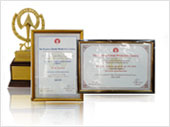About Us
Md's Message
Managing Director’s Statement
Nikhil Nanda
MY OVERVIEW CAN BE CONCISED IN JUST TWO WORDS: ‘PRIDE’ AND ‘PREPAREDNESS’
Until not too long ago, there was a tendency to look down on everything Indian.
Consumers who went out to buy products generally gravitated towards the international at best and anything that even sounded remotely international at worst.
The general conclusion was that if it is international, then it must be superior; if it was Indian, then it must be mediocre.
The biggest transformation of the last half-decade is a new-found pride in a number of things Indian.
Let me talk of what is happening in our space. The emergence of a deeply Indian brand like Patanjali from virtually nowhere is more than asign of product success; the robust growth of ITC’s foods and FMCG businesses are pivoted around a business model that extends from farm to fork; the rapid strides made by Emami indicatea growing traction for Ayurveda-based FMCG products; the rising trend for Dabur indicates a widening room for home grown success.
Besides, there area number of other developments at play: a growing scale achieved by these Indian companies, the manufacture of products that reconcile world-class standards with relevant customisation ,the growing penetration of these products into rural India, the engagement of home-grown role models to endorse these products and increasing competitiveness. The result is that most of these companies are not merely content to play for incremental market share; through the introduction of innovative products, they are keen to create markets that never existed.
The result of this transformation in national identity and pride is captured in the response of friends to our decision to emerge from the outsourcing shadow of a global multinational. When we announced this decision a few years ago, the first response was ‘How will you survive?’ When I explain our business model today, the reaction has largely changed to ‘Wow! It’s so nice of an Indian company to take on international brands.
The bottom line is that it is increasingly inconceivable that the second most populous consumption market in the world would need to depend on global brands for its everyday needs. On the contrary, the time has come for home-grown brands to capture a large slice of then Indian market, leverage the prevailing economies of scale and emerge as successful global brands in their own right.
Preparedness
It would be foolhardy to assume that a growing respect for Indian brands will raise the level of water for all ships.
In an Indian FMCG space populated by a variety of national and international brands, success will be derived through a convergence of diverse competencies.
One, a word-class standard.
An increasing number of consumers will seek to buy products not because they are Indian, but because they are outstanding and Indian….in that order. And here, I must add that the time has come when a number of Indian FMCG products are not just as good as international brands; they are better. Take the instance of Patanjali’s toothpaste; in the brief tenure of a couple of years, this single product has extensively transformed a decades-old habit of using white toothpaste into a respect for herb-based brown paste. What used to be so downmarket until not too long ago is now considered acceptable.
Two, future-readiness.
Indian brands will need to invest in research with the objective to create world-beating products instead of conventional reverse-engineering. Besides, Indian brands will need to plan infrastructure from a decadal perspective instead of going back to the drawing board every couple of years.
Three, advertising and promotion.
Indian companies will need to extend beyond merely putting products on shelf spaces; they will need to create world-class brands that inspire trust and loyalty.
Four, wider portfolio.
Indian companies will need to put a wide complement of products in the marketplace, so that the success of one feeds on the off take of another – and vice versa.
At JHS Svendgaard, we have invested with the objective of creating a future-ready company.
Even as we are in the process of turning around in the current financial year – the Company was cash-positive in each of the quarters of the last financial year – we are already engaged in aggressive capacity creation and balancing. The Company is investing around 40 crore in additional investment in the creation of a second manufacturing unit and the balancing of capacity at its first unit. This capacity is expected to be commissioned by the end of 2016-17 with the potential to generate an aggregate 500 crore in revenues at peak utilisation.
I would like to assure shareholders that in this second coming, we have progressively invested in extensive business derisking.
The reinvented JHS will be debt-free coupled with patient equity investors who have provided a significant part of the Company’s precious growth capital.
The reinvented JHS will not have any customer accounting for more than quarter of its revenues, compared to our previous incarnation when nearly 80% of our revenues were derived from our largest customer. The reinvented JHS will generate half its revenues from proprietary brands, an excellent revenue shock absorber from unforeseen declines in outsourced volumes.
The reinvented JHS has entered into five-year outsourcing contracts with prominent downstream customers as against the erstwhile practice of entering into renewable two-year engagements.
The reinvented JHS has rationalised its product portfolio, enhancing focus, specialisation and consequent economies of scale.
Overview
I am optimistic that in this second coming, JHS Svendgaard will respond with speed and sensitivity to the great Indian consumption boom, not only as an anonymous back-end for some of the most visible Indian brands but as a proud visible player capturing the attractive upside of the Indian consumption journey.
Nikhil Nanda,
Managing Director





